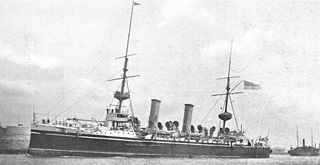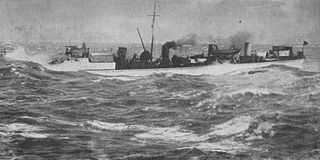
HMS Minerva was an Eclipse-class protected cruiser built for the Royal Navy in the mid-1890s.

HMS Hawke, launched in 1891, was the seventh British warship to be named Hawke. She was an Edgar-class protected cruiser.
HMS Wolf was a B-class torpedo boat destroyer of the British Royal Navy. She was completed by Laird, Son & Company, Birkenhead, in 1897.
HMS Orwell was a B-class torpedo boat destroyer of the British Royal Navy. She was built by Laird, Son & Company, and served from 1900 until 1920.
HMS Success was a B-class torpedo boat destroyer of the Royal Navy. She was launched on 21 March 1901. On 27 December 1914 she was wrecked off Fife Ness during heavy gales.

HMS Doris was an Eclipse-class protected cruiser built for the Royal Navy in the mid-1890s.
HMS Zebra was a "Twenty-seven Knotter" destroyer of the Royal Navy, later classified as part of the A Class. Zebra was built by Thames Iron Works and launched in 1895 as the fifth Royal Navy ship to be named Zebra. Entering service in 1900, Zebra was sold for scrap in 1914.

HMS Grafton was a first class cruiser of the Edgar class, launched in 1892. She served in colonial service and in the First World War. Grafton survived the war and was broken up in the 1920s.

HMS Berwick was one of 10 Monmouth-class armoured cruisers built for the Royal Navy in the first decade of the 20th century. She was assigned to the 2nd Cruiser Squadron of the Channel Fleet upon completion in 1903 and was transferred to the Home Fleet in 1906. She accidentally rammed and sank a British destroyer in 1908. Berwick was refitted in 1908–09 before she was transferred to the 4th Cruiser Squadron on the North America and West Indies Station later that year.

HMS Donegal was one of 10 Monmouth-class armoured cruisers built for the Royal Navy in the first decade of the 20th century. She was initially assigned to the 1st Cruiser Squadron upon completion in 1903 and ran aground en route to the China Station in 1906. She was briefly placed in reserve after repairs before she was assigned to the Home Fleet in 1907. She joined the 4th Cruiser Squadron on the North America and West Indies Station in 1909 before returning home for an assignment with the Training Squadron in 1912. Donegal was reduced to reserve before World War I began in August 1914 as part of the Third Fleet

HMS Lancaster was one of 10 Monmouth-class armoured cruisers built for the Royal Navy in the first decade of the 20th century. Upon completion she was assigned to the 3rd Cruiser Squadron of the Mediterranean Fleet. She remained there until 1912 when she returned home to be placed in reserve. The ship was recommissioned in 1913 for service with the 4th Cruiser Squadron on the North America and West Indies Station. She remained there until she was assigned to the Grand Fleet in 1915. She was transferred to the Pacific in 1916 and she became flagship of the Eastern Squadron in 1918. The ship was sold for scrap in 1920.

HMS Banshee was one of three Banshee-class destroyers which served with the Royal Navy.
HMS Peterel was one of two Spiteful-class destroyers to serve with the Royal Navy. She was built by Palmers, was 215 feet long and the 6,200 H.P. produced by her Reed boilers gave her a top speed of 30 knots. She was armed, as was standard, with a twelve pounder and two torpedo tubes. She served in home waters throughout the Great War and was sold off in 1919.
HMS Myrmidon was one of two Myrmidon-class destroyers which served with the Royal Navy.

HMS Talbot was an Eclipse-class protected cruiser built for the Royal Navy in the mid-1890s.

The Arrogant-class cruiser was a class of four protected cruisers built for the British Royal Navy at the end of the 1890s. One ship, HMS Gladiator, was lost following a collision with a merchant ship in 1908, while HMS Vindictive saw active service in the First World War, taking part in the Zeebrugge Raid in April 1918 before being sunk as a blockship during the Second Ostend Raid in May 1918.

HMS Dido was an Eclipse-class protected cruiser built for the Royal Navy in the mid-1890s.

HMS Usk was a Yarrow type River Class destroyer ordered by the Royal Navy under the 1901 – 1902 Naval Estimates. Named after the River Usk in Wales flowing through Newport, she was the first ship to carry this name in the Royal Navy.
HMS Leda was a Alarm-class torpedo gunboat of the British Royal Navy. She was built by Sheerness Dockyard from 1891–1893. She was converted to a minesweeper in 1908–1909 and continued these duties during the First World War. Leda was scrapped in 1922.

HMS Indefatigable, was a second-class Apollo-class protected cruiser of the British Royal Navy. The ship was built by the London and Glasgow Shipbuilding Company of Glasgow between 1890 and 1892, launching on 12 March 1891. In 1910, the ship was renamed HMS Melpomene, and in 1913 was sold for scrap.












